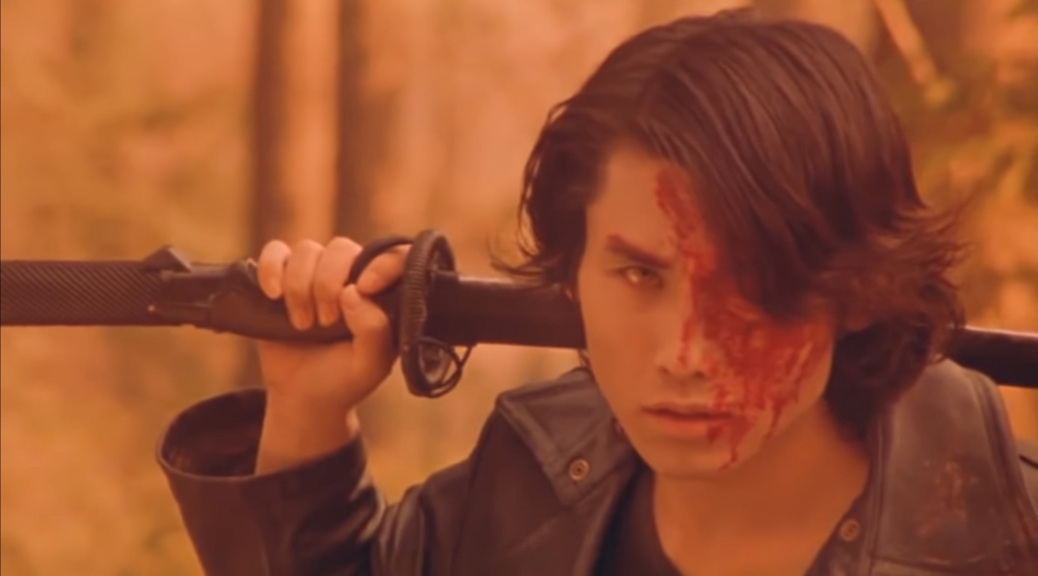
Versus (Ryuhei Kitamura, 2000, 119 min.)
Two escaped convicts, one of whom has a severed hand still attached to the other end of his handcuffs, wander through a deserted forest. Both are wearing jumpsuits that read “Lawbreaker” in large letters. They meet up with a bunch of yakuza in a deserted forest. It is clear that these gangsters had something to do with the jailbreak, but it is not clear what. The two groups of criminals take an instant disliking to each other, and there is much posturing and waving of guns. The yakuza have kidnapped a woman, and when they mistreat her, one of the escapees (prisoner KSC2-303, played by real-life street fighter Tak Sakaguchi) proclaims himself a feminist and shoots one of the gangsters. Unfortunately, this is the Forest of Resurrection, the 444th portal of 666 that connect this world to the other side, and the dead don’t stay dead here. The yakuza and the remaining escapee, who “rescues” the woman, quickly discover the many problems that stem from using the Forest of Resurrection as a dumping ground for murder victims, as the yakuza have been doing for some time. (There are also problems inherent in burying your victims with their guns still loaded, but let’s not get into that.) Mayhem, of a unique, frenetic, and almost crazily poetic kind, ensues.
I spent the few seconds between action sequences trying to piece together the film’s influences, in a “blank meets blank” format. The Evil Dead trilogy meets John Woo’s The Killer. Night of the Living Dead meets Akira Kurosawa. This is definitely the best zombie-yakuza-kung fu-vampire-swordfighting-Highlander-gross out-comedy I have ever seen, and possibly the best (or only) one ever made. Its nonstop blend of action, comedy, gore, and gang-movie posturing had me laughing out loud, marveling at the audacity and technical expertise involved in making it. It is guerrilla filmmaking in the Sam Raimi/first Evil Dead movie vein: the film was shot in two months on zero budget and without computer effects. That’s all real makeup, real stunts, and real camera angles you’re seeing, which is a breath of fresh air in the contemporary Hollywood era of digitization of everything. The camera never stops moving, nor do the principals.
There is a story, or at least the skeleton of one, but it is secondary to the film’s real purpose, which is to look great and keep your interest. It turns out that the main bad guy of the film (played by Hideo Sakai) is at least 500 years old; he needs the blood of the kidnapped woman (Chieko Misaka), who has been reincarnated. Prisoner KSC2-303 has been reincarnated too. He’s there to stop… no, wait… the bad guy needs Prisoner KSC2-303… wait. Never mind. It doesn’t matter, and in fact, toward the end of the film, when the insane zombie action slows down and they take the time to develop the plot, the film overstays its welcome.
The most entertaining character in the film is a flamboyant knife-wielding Christopher Walken wannabe played by Kenji Matsuda. He is hysterical as the strike-a-pose dandy early in the film. I underwent a change of heart about him during the film: at first, I thought he was great, then he got annoying, but by the time he basically turns into a crab vampire (well, sort of), he was my favorite character. Tak Sakaguchi is great as the laconic hero; he is always careful to artfully flip his leather trenchcoat around and maximize the cool factor of any move he makes. The film is eager to play off his parodic ultra-cool demeanor: in one scene he kills an undead guy (not a zombie, though) and takes his sunglasses. As the metal music swells on the soundtrack, he looks up at his babe, who shakes her head, and he puts the sunglasses back. When Hideo Sakaki, the lead bad guy, shows up with his posse of beautiful women loaded with guns, the film kicks up another notch. When it turns out that he’s actually some sort of ageless vampire who turns most of the characters who are still alive into super-kung-fu-vampires, well… I felt like a 14-year-old.
That this assured and expert film is the first feature from Ryuhei Kitamura is surprising, unless you think about other directors who managed to make the most out of inexperience, low budgets, and sheer enthusiasm, like Sam Raimi or Darren Aronofsky. This film is not for everybody; in fact, it’s probably not for most people. However, it has an energy and sense of humor and style that is sorely lacking in most Hollywood fare, and a special few people will think it is heaven-sent.

